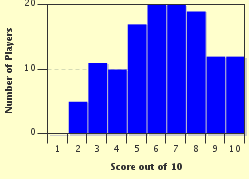Quiz Answer Key and Fun Facts
1. January 7, 1610: Galileo Galilei observes and identifies the first group of objects known to be orbiting another planet: these four moons of Jupiter are now known as the 'Galilean moons'. Which of these four alternatives is NOT one of the moons seen by Galileo at this time?
2. June, 1611: Having wintered ashore, when the ice cleared the captain of the ship wanted to press on westwards on his voyage of discovery. However, most of the crew wanted to return home, so they mutinied and cast the captain, his teenage son and seven crew members adrift in a small open boat, never to be seen again. Who was this captain?
3. April 11, 1612: Edward Wightman is executed by burning at the stake in Lichfield in Staffordshire. He is the last person to be executed in England for which offence?
4. February 7, 1613: The beginning of the reign of Michael I ended what has become known as the "Time of Troubles", a period of famine and civil uprising following the death of the last member of the Rurik Dynasty in 1598. Michael I was the first monarch from which dynasty?
5. April 7, 1614: After a short illness at the age of 72, one of the great painters, sculptors and architects of the Spanish Renaissance died in Toledo, where he had lived and worked for 37 years. Known for his tortuously elongated figures, he was disdained by generations of artists that followed him, but he was hugely influential on the likes of Picasso, Cezanne and Manet, who lived three centuries after him. Who is this artist?
6. 1615: The second and final part of a canonical novel is published ten years after the first part. Widely considered to be one of the founding works of modern Western literature, it still today features prominently in lists of the greatest works of fiction ever written. Which novel is this?
7. April 23, 1616: The world lost three of the greatest writers of their generation (many would say of all generations) all on the same day. One was the writer of the most important novel ever written in his language, one was the first writer born in the Americas to enter the Western canon, and one was a pre-eminent dramatist. Who did NOT die on this day?
8. April 4, 1617: mathematician, physicist and astronomer, John Napier of Merchiston died from the effects of gout aged 67 on this date. The bane of many a schoolchild since, Napier not only invented logarithms, but also popularized the use of the decimal point in arithmetic and mathematics. What nationality was Napier?
9. May 23, 1618: The 1555 Peace of Augsburg ended the on-going conflict between German Lutherans and Catholics. The 2nd Defenestration of Prague on May 23, 1618 re-ignited the situation and began one of the deadliest of all European religious wars (8 million died). How is this war now known?
10. March 2, 1619: The Queen consort of England, Anne of Denmark, died at the age of 44 in Hampton Court Palace on this date. Born in 1574, the second daughter of King Frederick II of Denmark, she had married at the age of 15 and in 1603 became the Queen consort of England and Ireland. Which of her three children would go on to be the English monarch?
Source: Author
EnglishJedi
This quiz was reviewed by FunTrivia editor
gtho4 before going online.
Any errors found in FunTrivia content are routinely corrected through our feedback system.

